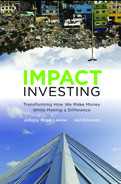
Impact Investing: Transforming How We Make Money While Making a Difference
Antony Bugg-Levine & Jed Emerson
306 pages, Jossey-Bass, 2011
Antony Bugg-Levine and Jed Emerson’s Impact Investing marks a transition in how we think about capital as a proactive positive change agent. The central theme of the book is that we are at an inflection point. The authors write: “The idea of impact investing for blended value—investment strategies that generate financial returns while intentionally improving social and environmental conditions—is disrupting a world organized around the competing principle that for-profit investments should seek only to pursue financial return, while people who care about social problems should give away their money or wait for government to step in.”
The book describes the emerging impact investing field, highlights its pioneers and leaders, and describes the conditions that will drive its growth. But the book also sets up the tensions in this transition. It asks such questions as: Will impact investing chart a smooth evolution or will it be the disruption that happens at major points of inflection and convergence? If the objective is to have impact investing strategies scale up, how will impact investment firms deal with mission continuity and organizational alignment as they transition into mainstream companies? What are the implications of impact investing going mainstream? If the principles of impact investing become accepted as sound investment fundamentals, do we transition simply to “investing for impact”?
A couple of years ago, I asked Emerson if impact investing would undergo an evolution like the one described by Geoffrey Moore in his book Crossing the Chasm. Moore’s central thesis is that market needs shift as early adopters transition from niche to mainstream investments (the chasm), and correspondingly new ranks of providers and leaders emerge to serve them.
Where is impact investing in this process? Bugg-Levine and Emerson do not answer this question directly. Yet during the last 30 years, there have been distinct changes in the underlying assumptions about the relationship between capital and its uses. In the early phase of socially responsible investing, the investor had to make a choice between profit and benefit (returns or impact). Now, with impact investing, there are opportunities where profits and impact are complementary and can coexist within a shared values framework (returns and impact). In the next phase, I believe that a model will emerge in which the outcome of sustainability and community benefit drives value creation and persistent lasting profits (returns from impact).
Bugg-Levine and Emerson examine microfinance’s role in the development of impact investing. They highlight the mission continuity challenges that microfinance firms face as they enter for-profit structures and public markets, and underscore that such transitions have unintended consequences. The authors also present examples of at-scale businesses that have retained their mission, such as Patagonia. And they point to the growth of the B Corp to indicate that growth, scale, and for-profit investment do not need to be at odds with mission.
Impact investing through private equity and venture capital investments are the main focus of the book. Yet impact investing is about much more than social enterprise and venture capital. Although the authors cover the Community Reinvestment Act and the New Markets Tax Credit, two US government programs that have channeled billions of dollars into disadvantaged communities through real estate and infrastructure investment and development, they do not plumb their importance. These programs have transformed decaying urban centers and uplifted distressed rural communities—spurring innovations in scalable impact finance by bringing together private investors, public funds, philanthropic funds, grants, tax incentives, debt, and equity. The programs have defined a powerful concept: Each type of investor wants to be rewarded in a different currency, and each defines returns in a very different way.
Today impact investing is being applied across the asset classes, in some cases reaching institutional scale and delivering institutional results. We have moved from a discussion of “good capital” to capital addressing social and environmental imperatives driven by global population growth and resource constraint. Think of firms like Lyme Timber, Jonathan Rose, Ecotrust Forest, and Bio-Logical Capital. Bugg-Levine and Emerson reference but do not fully explore the roles of these path-breaking firms. Nonetheless, they have written an important book, which defines this critical moment when mainstream investors are starting to recognize the opportunity to invest and make a difference. I look forward to their next book, the sequel that tells the story of the models and leaders in the next phase of impact investing’s evolution.
David Chen is CEO of Equilibrium Capital Group, which brings institutional investors a portfolio of sustainability-driven real asset funds.

